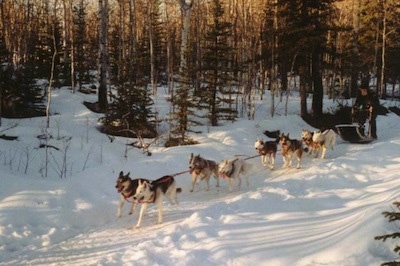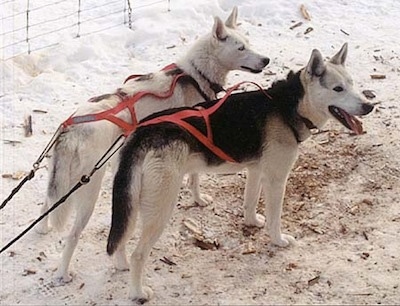
Photo courtesy of Seppala Kennels, Rossburn, Manitoba
--
While the Seppala used to be the same breed as the Siberian Husky today, it is considered a separate breed differing in appearance. Seppalas are the working lines and the Siberian Huskies are the show lines. Their legs and body are longer and they are generally lighter in weight and build than the show dogs. The ears are taller than those in the show lines, set closer together and are very erect. The stop is less defined than that in the show lines. The tail is naturally held high in a sickle curve over the back when alert. The coat is medium in length and dense with an undercoat nearly as long as their outer coat. Coat colors vary and are not considered important in the breed. Some common coat colors include pure white, buff, buff and white, black, charcoal gray, gray, brownish gray, blue-gray and sable (reds with black-tipped guard hairs and black noses). Piebald spotting and agouti (wild type) coloration are common. Some have dark faces with white only on the feet and tips of the tail. Eyes can be blue or brown, or any combination of the two.
This is an active working breed that will be docile and trainable when it is provided with enough exercise. This is a high-energy dog, especially when young. Seppalas are very intelligent and trainable, but they will only obey a command if they see the human is stronger minded than themselves. If the handler does not display leadership, they will not see the point in obeying. Training takes patience, consistency and an understanding of the Arctic dog character. If you are not this dogs 100% firm, confident, consistent pack leader, he will take advantage, becoming willful and mischievous. Seppalas make excellent jogging companions, as long as it is not too hot. This breed likes to howl and gets bored easily. Does not do well if left alone for a long period of time without a great deal of exercise beforehand. A lonely Seppala, or a Seppala that does not get enough mental and physical exercise can be very destructive. Remember that the Seppala is a true working sled dog in heart and soul. They are good with other pets if they are raised with them from puppyhood, but do like to hunt small game animals. Seppalas are thrifty eaters and need less food than you might expect. This breed likes to roam. Seppalas can make wonderful companions for people who are aware of what to expect from these beautiful and intelligent animals and are willing to put the time and energy into them.
Height: 22 - 23 inches (56 - 58 cm)
Weight: 40 - 50 pounds (18 - 23 kg)
Prone to allergies, cancer and eye problems.
They are not usually recommended for apartments, however they can live in apartments if well trained and properly exercised. Seppala Siberian Sleddogs are very active indoors and do best with a fenced-in, large yard. Because of their heavy coats, these dogs prefer cool climates. One has to use common sense with respect to maintaining them in the heat by providing adequate shade and air conditioning. This breed prefers to live in packs.
The Seppala Siberian Sleddog needs a lot of exercise. When not pulling a sled the breed needs at least a daily walk or jog, but should not be excessively exercised in warm weather.
About 12-16 years.
About 6 to 8 puppies
The coat sheds heavily twice a year. During that time they need to be brushed and combed daily.
The Seppala Siberian Sleddog was at one time the same breed as the Siberian Husky. It was always the working lines of the breed and was never used in the show ring. As the show ring dogs evolved more for their beauty and less for sled pulling, the Seppala Siberian Sleddog remained a true working dog. The bloodlines were kept separate from the show dogs. In the late 1990s, the breed was recognized by the Canadian agriculture authorities as a new breed. In 2002 the Seppala Siberian Sleddog lines spread to the USA as breeders worked on keeping the working lines separated from the show lines.
Working
--

Photo courtesy of Seppala Kennels, Rossburn, Manitoba

Seppala Siberian Sleddog puppy, photo courtesy of Seppala Kennels, Rossburn, Manitoba

Photo courtesy of Seppala Kennels, Rossburn, Manitoba

Photo courtesy of Seppala Kennels, Rossburn, Manitoba
Photo courtesy of Seppala Kennels, Rossburn, Manitoba

Photo courtesy of Seppala Kennels, Rossburn, Manitoba